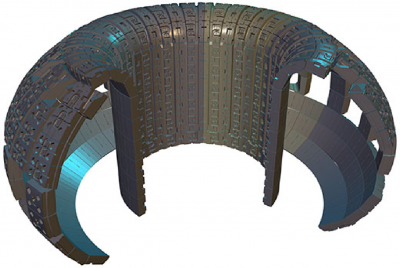Breeding blanket: Difference between revisions
Jump to navigation
Jump to search
No edit summary |
|||
| Line 11: | Line 11: | ||
== See also == | == See also == | ||
* The [[TECNO FUS]] project | * The [[TECNO FUS]] project | ||
* [[EUROBREED]] | |||
== References == | == References == | ||
<references /> | <references /> | ||
Revision as of 09:13, 12 January 2012

The breeding blanket consists of a set of modules covering the interior of the fusion reactor vessel, capable of supporting a high heat load and an intense neutron flux. Its main purpose is threefold:
- to assure self-sufficiency of the fusion reactor with regard to tritium (by producing, from lithium, at least the same amount of tritium as that which is consumed in the plasma),
- to maximise the net efficiency of the power plant (by assuring the highest possible temperature of the coolant), and
- to act as a radiation barrier (such that the components behind the breeding blanket receive the lowest amount of radiation possible).
Currently, Europe is developing two alternative concepts for the breeding blanket of DEMO, both based on helium cooling, which must be tested in experiments to be performed at ITER. One is based on liquid metal, and the other on the use of Li and Be ceramics (acting as neutron multipliers) in the shape of small spheres. [1]